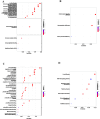A novel gene signature for forecasting time to next relapse in multiple sclerosis using peripheral blood mononuclear cells
- PMID: 40597893
- PMCID: PMC12210466
- DOI: 10.1186/s12883-025-04231-3
A novel gene signature for forecasting time to next relapse in multiple sclerosis using peripheral blood mononuclear cells
Abstract
Aim: The purpose of this research study was to develop and validate a gene signature based on peripheral blood mononuclear cells (PBMCs) for predicting the time to the next relapse in multiple sclerosis (MS).
Methods: The GSE15245 dataset (N = 94) was divided into a training set (N = 65) and a testing set (N = 29). First, the training set was analyzed using weighted gene co-expression network analysis (WGCNA) to identify key modules that were highly correlated with the timing of the next acute relapse. Subsequently, the hub genes within these key modules were subjected to univariate Cox regression analysis, and genes related to the recurrence time of MS were identified. The least absolute shrinkage and selection operator (LASSO) Cox regression was used to refine the extraction further. Then, the gene signatures were constructed using multivariate Cox regression. The efficacy of the model that was based on the training set database was evaluated using receiver operating characteristic (ROC) curves and validated using an independent testing set. Additionally, gene signatures were also validated for differential expression using an external independent dataset, GSE21942 (N = 29), along with experimental verification.
Result: Two key modules were identified with WGCNA. Univariate Cox regression analysis yielded 30 genes related to the relapse time of MS from these two modules, and then LASSO regression analysis further refined the selection to four genes, namely, BLK, P2RX5, GP1BA, and PF4. These four genes were used within the training dataset to build a Cox regression model, and this showed high prediction performance in the training as well as the testing datasets. Both external dataset analysis and experimental validation corroborated the differential expression of BLK and P2RX5 in patients with MS.
Conclusion: BLK, P2RX5, GP1BA, and PF4 emerge as potential predictors of future disease activity in individuals with MS.
Keywords: Cox regression; Gene signature; Multiple sclerosis; Peripheral blood mononuclear cells; Relapse prediction.
© 2025. The Author(s).
Conflict of interest statement
Declarations. Ethics approval and consent to participate: This study protocol was approved by the Ethics Committee of Zhuzhou Central Hospital (approval number: ZZCHEC2000044-01). This study was conducted in accordance with the declaration of Helsinki. Written informed consent was obtained from all participants. Consent for publication: Not applicable. Competing interests: The authors declare no competing interests.
Figures






References
-
- Koch-Henriksen N, Magyari M. Apparent changes in the epidemiology and severity of multiple sclerosis. Nat Rev Neurol. 2021;17(11):676–88. - PubMed
-
- Dobson R, Giovannoni G. Multiple sclerosis - a review. Eur J Neurol. 2019;26(1):27–40. - PubMed
-
- Ontaneda D, Hyland M, Cohen JA. Multiple sclerosis: new insights in pathogenesis and novel therapeutics. Annu Rev Med. 2012;63:389–404. - PubMed
MeSH terms
LinkOut - more resources
Full Text Sources
Medical
Miscellaneous

